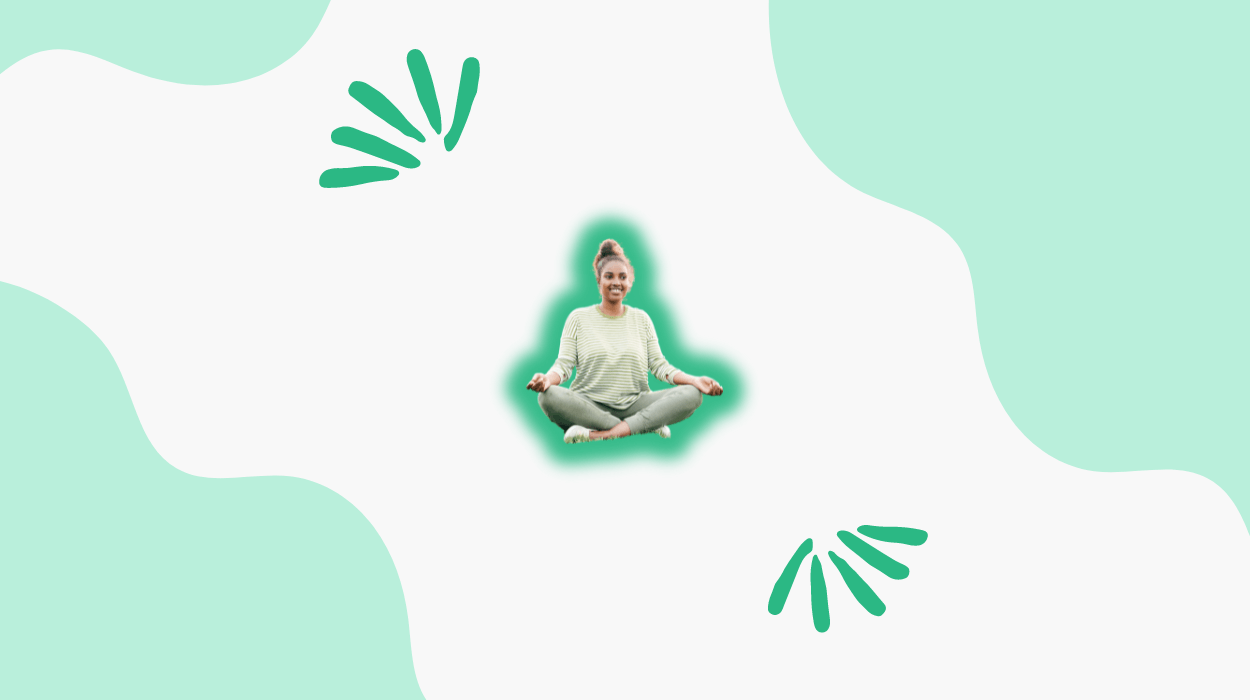

Persistent anxiety may negatively impact your mental and physical well-being and be bothersome to manage. However, employing mindfulness-based interventions could help alleviate anxiety frequency and severity.
Mindfulness implies observing one’s thoughts, emotions, and experiences without judgment. This approach may be beneficial in reducing anxiety as it may shift the focus from past regrets or future fears to the immediate experiences in the present.
It could encourage people to engage with their anxiety in a more compassionate and understanding manner by embracing acceptance rather than resistance.
The article will list the best mindfulness exercises for reducing anxiety and explain their mechanism. It will also examine the efficacy of mindfulness practices and their potential limitations regarding anxiety reduction.
Mindfulness emphasizes being fully engaged in the current moment by letting go of past regrets and future worries. It involves observing experiences, thoughts, and emotions without labeling them good or bad.
It requires deliberately directing attention, whether on the breath, sensations, or activities. When the mind wanders, the practice involves gently bringing the focus back to the present moment without criticism.
Research indicates that Mindfulness may serve as a potent antidote to anxiety, providing people with a means to redirect their attention away from worries and towards a deeper connection with life.
Mindfulness practices may include meditation, daily mindfulness activities, and breathing exercises. These practices may help cultivate a heightened sense of awareness and reduce the grip of anxiety on everyday life.

Mindfulness practices may help people cope with multiple anxiety symptoms. Here are five anxiety symptoms that Mindfulness could assist with:
Mindfulness exercises might help cultivate a sense of presence, reduce stress, and promote overall mental wellness.
| Exercise | Description | Benefits |
|---|---|---|
| Deep Breathing | Focus on gradual, deep breaths to calm the mind and body | Reduces anxiety symptoms, promotes relaxation |
| Body Scan Meditation | Methodically scan through the body, noticing sensations without judgment | Increases body awareness, helps release tension |
| Mindful Walking | Pay close attention to each step and the sensations of walking | Grounding technique promotes mindfulness in motion |
This intentional practice requires you to sit quietly for a specified period (a few minutes to some hours) and focus on your thoughts and feelings without judgment. It may promote a sense of presence and inner peace amidst the chaos of the mind.
Some people may prefer repeating simple words or phrases with each breath, which aids in maintaining their focus and calming the mind.
Meditation apps like Headspace or Calm may provide guidance and structure for beginners, helping them navigate the meditation practice effectively.
Setting mindful intentions could help you focus and remind you why you are practicing Mindfulness in the first place. These intentions may serve as guiding principles that help navigate emotions and reactions with Mindfulness and compassion.
When creating mindful intentions, focusing on self-care and self-compassion is essential. For instance, setting an intention like “I will prioritize self-care and treat myself with kindness” may shift the internal dialogue from self-criticism to self-nurturing.
Such intentional shifts may significantly impact how you perceive and respond to anxiety triggers. Mindful intentions should be realistic and attainable to help build confidence and motivation, reinforcing a positive cycle of self-improvement.
Performing grounding exercises may stimulate all five senses and bring you back to the present by focusing on sensory experiences. When feeling overwhelmed, grounding exercises may aid in diverting attention from anxious thoughts and behaviors.
Here is a table illustrating examples of grounding movements:
| Grounding Movements | Sensory Experience | Example |
|---|---|---|
| Touch | Feel the texture of an object | Rubbing a soft blanket between fingers |
| Sight | Focus on colors and shapes | Observing the details of a painting |
| Sound | Listen to specific sounds | Noticing the birds chirping outside |
| Smell | Inhale different scents | Taking a whiff of fresh coffee |
| Taste | Savor flavors in your mouth | Enjoying a piece of dark chocolate |
Focusing on the breath may help in times of heightened anxiety. It could bring your attention back to the present moment and ease the overwhelming feelings that often accompany anxiety.
Here are five effective breathing exercises to incorporate into your daily routine:
The progressive Muscle Relaxation technique involves systematically tensing and relaxing different muscle groups to promote a more profound sense of relaxation.
You might learn to recognize and mitigate the physical manifestations of anxiety by bringing awareness to the body’s physical sensations.
Starting from the feet and progressing upwards, you may focus on each muscle group, intentionally tensing them before releasing the tension. The process may help release held-back physical tension and increase awareness of the mind-body connection.
Progressive muscle relaxation can be practiced discreetly in various settings. Whether waiting in line, sitting at work, or before bedtime, this technique could be helpful to tune into the body’s signals and alleviate stress/anxiety.
Mindful walking may allow you to connect with the surroundings and inner sensations, promoting a sense of calm and relaxation.
Pay attention to the feeling of your feet on the floor, noticing textures and temperature. Tuning in to the physical sensations may anchor you in the present moment.
Experiment with moving very slowly during your walk. It might help you fully experience each movement and stay in tune with your body.
Sync your breath with your steps, maintaining a steady rhythm. This synchronization may enhance the mind-body connection and deepen your sense of awareness.
Paying attention to a single activity may help you fully immerse yourself in the present moment. Single-tasking might help mitigate feelings of overwhelm and anxiety that often arise from attempting to juggle multiple tasks simultaneously.
Focusing on one thing at a time may help you concentrate better with undivided attention to the task, leading to a more thorough and efficient activity completion.
It may give you a sense of accomplishment and satisfaction as each task is carried out mindfully. The focused awareness of the present moment may help reduce stress and worry.
Journaling may allow you to express your thoughts and emotions on paper without fear of judgment. It may help you gain insights into your emotions and behaviors.
Maintaining a journal might aid in reducing feelings of anxiety by providing a structured outlet for reflection and self-awareness. Putting your feelings into words may help you process and make sense of them, reducing emotional intensity.
Constant connectivity to phones, computers, and televisions may overwhelm the mind and lead to heightened levels of anxiety. Frequently checking your social media or browsing through videos might affect your productivity and increase anxiety.
Try immersing yourself in screen-free activities, like reading a book, going for a stroll, engaging in a hobby, or simply sitting in quiet contemplation. These activities may allow you to focus on the present moment, reconnect with your surroundings, and tune into your inner thoughts and feelings.
Mindfulness may work by inducing a profound shift in one’s thoughts and emotions. It may help you focus on the present moment. It may enable you to redirect your attention away from worries, helping you establish a new and healthier relationship with life.
Instead of resisting anxiety, Mindfulness might encourage the acceptance of anxious feelings, allowing you to acknowledge emotions without judgment.
Regularly engaging in mindfulness practices could cultivate better self-regulation and enhance emotional resilience.
Mindfulness techniques like body scans, deep breathing, and mindful walking may also encourage relaxation and minimize reactivity to stress/anxiety.
People with social anxiety may exhibit anxiety signs like avoiding eye contact, refraining from social gatherings, and rapid heartbeat. Such symptoms might hinder their ability to engage in social interactions effectively.
Mindfulness practices may improve self-confidence in social situations by reducing the focus on negative self-judgment. It may enhance present-moment awareness in social interactions, allowing you to engage more authentically.
During a panic attack, physical symptoms such as sweating, trembling, rapid heartbeat, or nausea may be debilitating. Mindfulness could be effective in regaining control and managing panic attacks effectively.
Focusing on a specific object or imagining a calming scene while engaging all senses may help shift attention away from the panic-inducing sensations. Doing so could promote a sense of calm and grounding.
Taking slow and deep breaths might help reset the nervous system and alleviate the physiological response to panic attacks.
People with generalized anxiety disorder(GAD) may struggle with constant feelings of apprehension and tension, which makes it challenging to focus on the present moment. G
Mindfulness could help manage GAD by redirecting attention away from excessive worries towards the present experience.
Mindfulness techniques may induce calmness and relaxation, improve emotional resilience, and mitigate anxiety severity in GAD.
Deep breathing exercises and mindful walking could help people with GAD ground themselves in the present moment.
Mindfulness could help manage anxiety and promote mental well-being. However, it may not provide immediate relief during acute anxiety episodes. It may be employed as a long-term strategy to prevent anxiety episodes.
Regular and sustained practice of Mindfulness is necessary to reap its benefits for anxiety reduction. Doing so could be difficult for some individuals to maintain. Mindfulness may help manage symptoms, but it may not always address the root causes of anxiety.
People with mobility issues, respiratory problems, or trauma histories may find mindfulness practices triggering or challenging.
Thus, everyone responds differently to mindfulness practices; what works well for one person may not be as effective for another.
Potential downsides of Mindfulness may include:
Studies have depicted that mindfulness practices may impart moderate health benefits like improved attention, memory, mood management, and anxiety relief.
Mindfulness could directly impact the brain, particularly by strengthening the hippocampus. Such a mechanism may positively impact stress responsiveness and emotional control.
To further illustrate the effectiveness of mindfulness for anxiety, the following table presents key research findings:
| Study | Results | Impact |
|---|---|---|
| Randomized controlled trials, including participants | Improved attention, memory, mood management, and anxiety symptoms relief | Enhances cognitive function and emotional well-being |
| Psychiatric Research: Neuroimaging | Mindfulness increases gray matter in the hippocampus, which is responsible for stress responsiveness and emotional control | Reduces anxiety and improves stress response |
| UCLA Study | Mindfulness reduces anxiety, enhances decision-making, and lowers emotional reactivity to stressors | Promotes stress resilience and emotional regulation |
Mindfulness is an attitude towards life that may encourage present-moment awareness and non-judgmental acceptance of thoughts and feelings. It may help enhance mental clarity, build emotional resilience, and minimize mental fatigue.
Practicing Mindfulness regularly may help calm your mind and keep negative thoughts and emotions offshore.
Try engaging in a daily mindfulness/meditation session of at least 5–10 minutes and perform mindfulness interventions you enjoy.
There are limitations to Mindfulness for anxiety. However, its efficacy in tackling specific anxiety disorders like GAD, social anxiety, and panic attacks demonstrates its potential as a tool for enhancing mental well-being.
Tyler Read earned an undergraduate academic degree from Sonoma State University, California and is a certified personal trainer (CPT) with NASM (National Academy of Sports Medicine). With over 16 years of experience, Tyler has trained clients both online and in-person.
He is passionate about helping others turn their love for fitness into a career. Tyler has worked with many local and commercial gyms before establishing his successful private personal training business, which he continues to operate.
